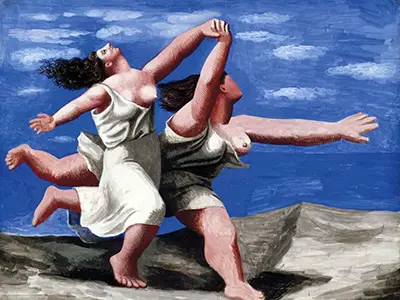It is a miniature piece, on plywood. It was painted using gouache, a watercolour paint which results in a more opaque finish than standard watercolours.
The painting depicts two women, dressed in a classical style, racing across a beach. As they run, hand in hand, arms aloft, their clothes appear to be falling off. They seem to be oblivious to their state of undress, as they dash across the sand.
They are running at speed, with joyful abandon, hair blowing in the wind. One woman is staring at the sky, while the other is looking towards the sea.
The work is painted from a strange perspective, with the woman in the background appearing much larger than one in the foreground. Her body looks strangely distorted, with her right leg extending far behind her, much further than would be humanly possible.
Her left leg also appears to be at a strange angle, in front of the woman in the foreground. As such, the larger of the two women appears to envelop the smaller, managing to be both behind and in front of her, at the same time. It is unclear if they are racing, but the larger woman appears to be striving to stay ahead of her companion.
The left arms of both women appear to be longer and thicker than the right. Again, this plays with the perspective, with the arms closest to the viewer being smaller than the limbs further away.
Both women are portrayed with tanned bodies, painted, in sharp relief, against a brilliant blue background of sea and sky.
As with many of his paintings from this period, Picasso alludes to a classical style. It is often said the two women resemble “maenads,” passionate female followers of Dionysius, the Greek god of wine. Certainly, the clothing of both women appears to be of Greek origin.
Although classical in style, “Two Women Running on the Beach” is the antithesis of much of his other work during this period, eschewing the formal approach for an altogether more carefree attitude.
A much larger version of this work was used, as a backdrop curtain, in the staging of the ballet “Le Train Bleu.” Set in the prestigious French resort of Deauville, this ballet depicted the lifestyle of the rich and famous, of the time. The title came from the name of the train, which transported them from Calais to the beach.
Unsurprisingly, for someone born in Spain, the beach is a recurring theme in Picasso’s work and is the subject of many paintings, “Bather with Beach Ball” and “The Bathers” being two further examples. However, few of his beach paintings evoke such a joyous image, of a day spent in the sun, as “Two Women Running on the Beach.”
He was hugely influential in the creation of modern art, and, arguably, the most famous painter of the 20th Century.
Throughout his life, Picasso continually developed and embraced new ideas and styles. He worked, tirelessly, to create thousands of paintings, prints and sculptures.
Unlike many artists, whose work is only appreciated after their death, Picasso enjoyed much fame and fortune during his lifetime.

